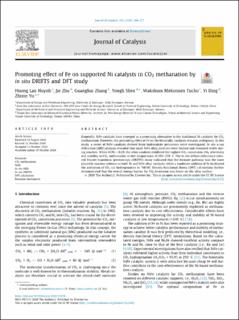| dc.contributor.author | Huynh, Huong Lan | |
| dc.contributor.author | Zhu, Jie | |
| dc.contributor.author | Zhang, Guanghui | |
| dc.contributor.author | Shen, Yongli | |
| dc.contributor.author | Tucho, Wakshum Mekonnen | |
| dc.contributor.author | Ding, Yi | |
| dc.contributor.author | Yu, Zhixin | |
| dc.date.accessioned | 2023-02-09T11:29:21Z | |
| dc.date.available | 2023-02-09T11:29:21Z | |
| dc.date.created | 2020-11-11T09:16:47Z | |
| dc.date.issued | 2020-12 | |
| dc.identifier.citation | Huynh, H.L., Zhu, J., Zhang, G., Shen, Y., Tucho, W.M., Ding, Y. & Yu, Z. (2020) Promoting effect of Fe on supported Ni catalysts in CO2 methanation by in situ DRIFTS and DFT study. Journal of Catalysis, 392, 266-277. | en_US |
| dc.identifier.issn | 0021-9517 | |
| dc.identifier.uri | https://hdl.handle.net/11250/3049630 | |
| dc.description.abstract | Bimetallic NiFe catalysts have emerged as a promising alternative to the traditional Ni catalysts for CO2 methanation. However, the promoting effect of Fe on the bimetallic catalysts remains ambiguous. In this study, a series of NiFe catalysts derived from hydrotalcite precursors were investigated. In situ x-ray diffraction (XRD) analysis revealed that small NiFe alloy particles were formed and remained stable during reaction. When Fe/Ni = 0.25, the alloy catalysts exhibited the highest CO2 conversion, CH4 selectivity and stability in CO2 methanation at low temperature of 250–350 °C. The in situ diffuse reflectance infrared Fourier transform spectroscopy (DRIFTS) study indicated that the formate pathway was the most plausible reaction scheme on both Ni and NiFe alloy catalysts, while a moderate addition of Fe facilitated the activation of CO2 via hydrogenation to *HCOO. Density functional theory (DFT) calculations further demonstrated that the overall energy barrier for CH4 formation was lower on the alloy surface. | en_US |
| dc.language.iso | eng | en_US |
| dc.publisher | Elsevier Ltd. | en_US |
| dc.rights | Navngivelse 4.0 Internasjonal | * |
| dc.rights.uri | http://creativecommons.org/licenses/by/4.0/deed.no | * |
| dc.subject | katalyse | en_US |
| dc.title | Promoting effect of Fe on supported Ni catalysts in CO2 methanation by in situ DRIFTS and DFT study | en_US |
| dc.type | Peer reviewed | en_US |
| dc.type | Journal article | en_US |
| dc.description.version | publishedVersion | en_US |
| dc.rights.holder | © 2020 The Author(s). | en_US |
| dc.subject.nsi | VDP::Teknologi: 500 | en_US |
| dc.source.pagenumber | 266-277 | en_US |
| dc.source.volume | 392 | en_US |
| dc.source.journal | Journal of Catalysis | en_US |
| dc.identifier.doi | 10.1016/j.jcat.2020.10.018 | |
| dc.identifier.cristin | 1846786 | |
| cristin.ispublished | true | |
| cristin.fulltext | original | |
| cristin.qualitycode | 2 | |

